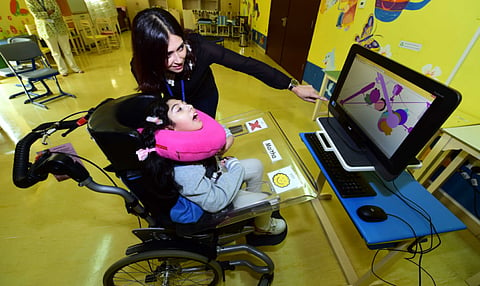Girl with cerebral palsy turns designer
Inspiring story of a 12-year-old special child who creates masterstrokes with her gaze and how her hi-tech art has caught the fancy of fashion houses

Dubai: Maitha Tariq, 12, is severely challenged. Diagnosed with cerebral palsy, she cannot talk, walk or use her hands. She even has to be tube-fed as she cannot eat on her own.
Yet, Maitha is making a splash.
Strapped to a customised wheelchair at the Al Noor Training Centre for Children with Special Needs, she looks into a computer screen with her eyes creating a masterstroke with every gaze. Thanks to what her teachers call assistive technology (AT), blobs of different colours appear on the screen, resulting in brilliant pieces of art. Soon these designs will go haute couture as leading fashion houses will incorporate them into fabric prints to make designer clothes.
“Our aim is to achieve this shift in perception. We don’t want people to buy goods amateurishly constructed by special needs children out of sympathy. If the exacting fashion industry can accept and harness whatever talent they have, they can be productive to a very qualitative standard. No matter how different a child is, he or she will still have some potential that can be tapped,” said Al Noor’s director Isphana Al Khatib.
The Al Noor Ladies Luncheon Fashion Show on January 28 will be the first to use Maitha’s designs. In the past too, Al Noor students have embroidered garments for Majid Al Futtaim fashion shows.
To make the seemingly impossible possible, the school has introduced a raft of new assistive technologies. “We have over 50 kinds of equipment that are capable of changing the lives of our special needs students and enhancing their independence, productivity and quality of life,” said Deepika Gopala Rao, co-ordinator of special services.
Eye-gaze technology
Eye-gaze technology, for instance, enables cerebral palsy students to operate a computer or tablet. An eye-gaze camera tracks eye movements which in turn controls the mouse. The mouse is used to select items on the computer screen either by holding eye-gaze for a set amount of time, by blinking or by clicking an external button. Eye-gaze technology, also called eye tracking, is available for different uses, including simple games to develop visual skills and complex computer control.
Maitha’s class teacher Shahanaz Mohammed said her progress on the eye-gaze learning curve was remarkable for someone whose meals - be it milk, soup, juice or just water – had all to be tube-fed. “Maitha is working with random colours at the early stages of the curve now. She has shown tremendous potential to grow her talent with the necessary training.”
Buoyed by the success of such ATs, Isphana said the school is hosting an exhibition and conference to raise greater awareness about such technologies. The Al Noor Assistive TechX 2015 will be held on November 12 and 13. The event is open to all with special training sessions on the various technologies for parents and their special needs children. “We will also be providing a unique AT experience where people can interact with students. The conference will be addressed by eminent speakers,” said Deepika, adding that social media campaign (#IamATaware) has also been planned.
YOUSPEAK: Did this story inspire you? What are your thoughts on it?
Sign up for the Daily Briefing
Get the latest news and updates straight to your inbox


